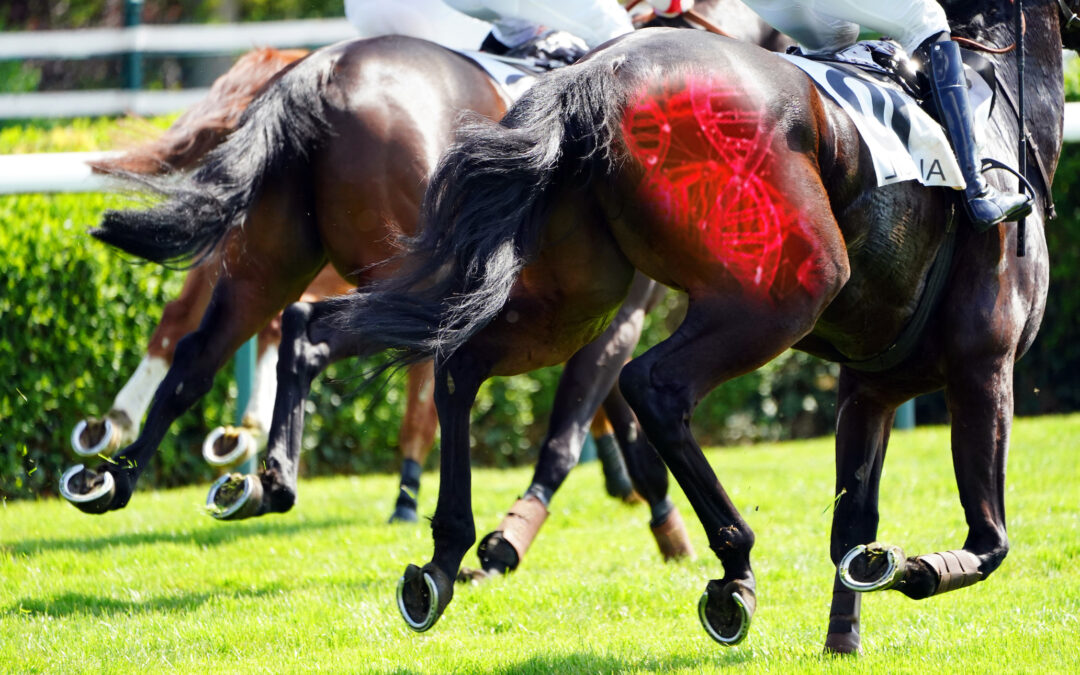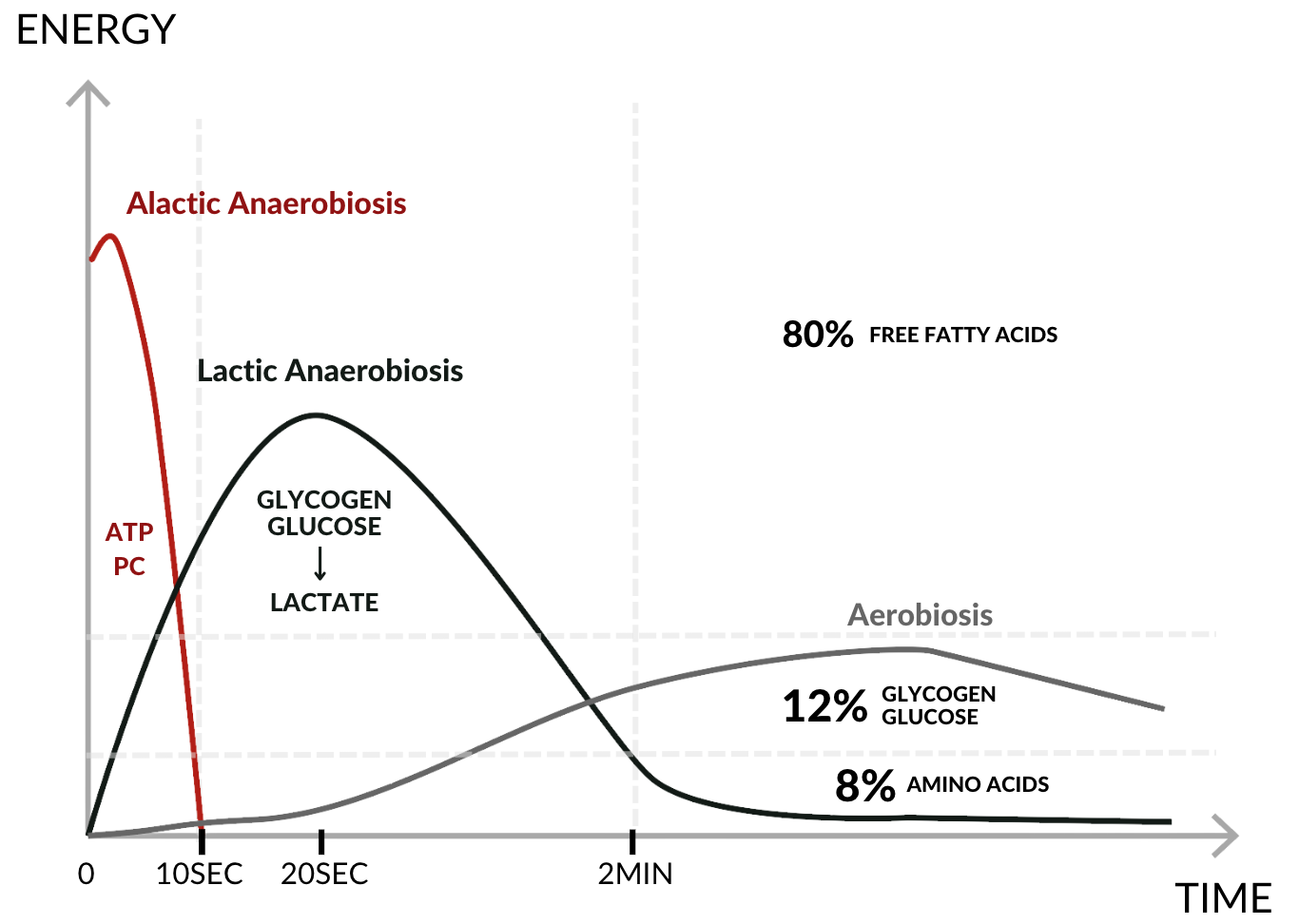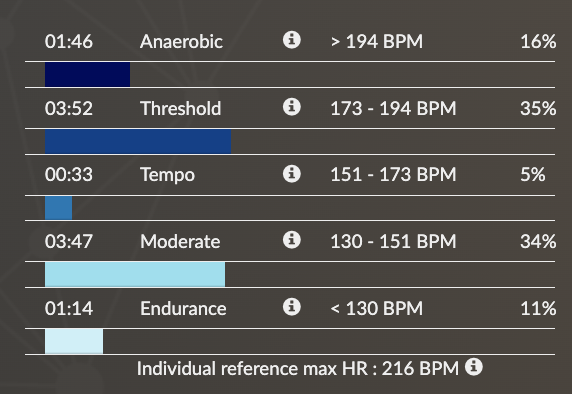How do racehorses create energy? To better analyse heart rate, recovery and objectively assess your horses’ fitness, it is useful to investigate the physiological mechanisms involved when the athletic horse is training.
In this article you will learn how the process of energy production in racehorses works, so that you can apply it to their training.
Energy creation in racehorses and ATP: definitions
To produce a physical effort, the body and, more precisely the muscle cells, need energy, fuel. This energy source is called adenosine triphosphate, or ATP.
Every exercise, whatever its intensity, requires an energy supply from the ATP molecule. It is the most essential energy component as it allows the muscles to produce the exercise. It is the only source of energy used for muscle contraction and release.
The first and quickest way to create ATP is to use the ATP already in the horse’s body. Indeed, this molecule is already naturally present in the body thanks to a very small stock in the muscle cells. Unfortunately, this first method of ATP production only works for a few seconds, because the muscles are only capable of stocking a limited quantity of ATP. The effort can only be maintained for a few seconds.
Without a sufficient supply of ATP, the muscle filaments can’t produce energy efficiently. Therefore, for a horse to sustain an effort of more than a few seconds, he must be able to re-synthesise ATP quickly and more permanently.
The process of energy creation in racehorses
To continue to fuel the muscles cells with energy once the resources have been exhausted, we know that the horse produces ATP differently when he is exercising more intensely.
According to the intensity of the effort, the body uses different metabolisms to create this energy.
Aerobic metabolism
The second way of producing ATP is the most efficient one: the aerobic metabolism. When a horse is running at a slow speed, his body mainly uses the degradation of fats by oxygen to produce energy. Then, the horse will use the oxygen in his environment and convert it into CO2, water, heat and lots of ATP. The advantage of this mechanism is its efficiency, almost inexhaustible and doesn’t produce lactic acid, which is a source of pain.
It’s also the slowest way to produce ATP and the quantity of energy delivered is limited by the amount of oxygen the horse can assimilate. This amount depends on various parameters such as lung volume, respiratory rate, heart volume, efficiency of cardiac contraction. The amount of oxygen that can be assimilated is for example limited by the maximum heart rate (HRmax), which is specific to each horse, varies slightly with age and training, and is not an indicator of fitness. Once the maximum heart rate is reached, the volume of oxygen taken in can hardly be increased.
The aerobic production of ATP will thus be sufficient for a required effort such as a slow trot or canter, but is not appropriate for higher speeds because it’s not fast enough.
AEROBIC METABOLISM
- The most efficient way of making ATP
- Requires good oxygenation to produce ATP from fatty acid or amino acids
- Unfortunately, this is also the slowest way of producing ATP, and you can only exercise as fast as you can make ATP
- The horse can only use this approach exclusively for slow-to-moderate exercise
Anaerobic metabolism
The last and fastest way to produce energy is anaerobic metabolism. When the effort becomes very high, the fats can’t generate energy fast enough. The horse’s body will then burn up the glucose and glycogen (sugar) reserves that are stored directly in his muscles, without using oxygen. Glycogen, unlike fat, is in limited supply in the body, but its degradation is fast and produces more energy.
However, this process produces a waste product: lactic acid. If there is not enough oxygen in the blood to eliminate it, it accumulates in the muscles, degrades the quality of contraction and can cause pain. This is why the effort is to be limited in time and can’t last forever.
ANAEROBIC METABOLISM
- The fastest way of making ATP
- This is what can fuel bursts of exercise, such as a sprint around a rodeo ring
- Very fast, but not very efficient, and eventually the horse will need to do something about that lactic acid that is left over
Diagram summarising energy production by time period
Energy creation and training
With training, the horse’s body optimises the process of energy creation and consumption. At a given speed, it needs less energy, and less oxygen, which results in a lower heart rate at that speed. A trained horse will be able to run faster and longer without producing lactic acid. Also, a horse that is trained in his anaerobic zone on a regular basis (above his threshold), becomes able to better handle lactic acid: its effects on muscle function will be reduced. However, these sessions are very demanding and should be handled with care.
Data from the Equimeter platform
The horses’ effort zones can be defined according to his FCmax:
- Up to 70% of FCmax: the body uses fat as its main source of energy. This is the aerobic phase.
- Between 70 and 80% of FCmax: fat continues to be consumed but the difference is made up by glycogen. The body is still able to supply enough oxygen to eliminate lactic acid. This is the anaerobic alactic phase.
- 80% to 90% of FCmax: from this threshold the body starts to accumulate lactic acid. The more it accumulates, the less efficient the muscular contraction is. This threshold is associated with a speed called the MAS (Maximum Aerobic Speed) which is the maximum speed that can be reached without producing lactic acid. This is the anaerobic lactic phase.
- At 90% to 100% of the maximum speed: the body accumulates a lot of lactic acid. It becomes painful for the muscles and the body to endure the exercise.
Monitoring your horse with a tool like EQUIMETRE can help you to know how long your horse has been in a specific effort zone during training.
Notice that at the beginning of an exercise, all three sources of energy production are started. The aerobic phase, using fat, is the slowest to set up, but it’s the one which offers the best performance. This is why the warm-up is so important to allow the different processes to take place correctly, and thus, maintain the physical and mental integrity of the horse throughout his training.
Conclusion
The horse is a formidable athlete with a remarkable physiological system that can adapt to the work required. Thanks to the different ways of producing energy, the horse is able to supply different levels of effort depending on the discipline in which he is evolving. Observing your horse’s response to effort, through parameters such as heart rate and recovery, is an excellent way to check your horse’s fitness.
Key words: training, energy production, ATP, Equimetre





